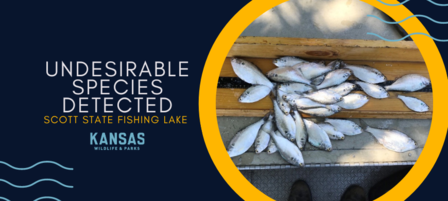Biologists Detect Undesirable Species at Scott State Fishing Lake

For Immediate Release:
Sept. 29, 2022
Contact:
Nadia Marji CMP®, Chief of Public Affairs
(785) 338-3036
nadia.marji@ks.gov
Biologists Detect Undesirable Species at Scott State Fishing Lake
HAYS – Reports from the public of alleged “intruders” in Scott State Fishing Lake were recently confirmed by Kansas Department of Wildlife and Parks (KDWP) Fisheries biologists in late August 2022. Fisheries staff confirmed the presence of gizzard shad, Dorosoma cepedianum, in the spring-fed lake – 91 gizzard shad that averaged 5.7 inches long to be precise – during an exploratory electrofishing survey.
Based on the gizzard shad sampled, staff are confident the majority were hatched just this year.
“Given the relatively high abundance and young age, it’s likely that most of the current population was produced in Scott State Fishing Lake and not the result of immigration or stocking,” said KDWP district Fisheries biologist Dave Spalsbury.” Well, it wasn’t Department-led stocking, that is.
“Gizzard shad were not stocked by KDWP, so the Scott State Fishing Lake population originated via natural immigration during our high flow-through event in May 2021, or through unauthorized public stocking,” added Spalsbury.
While the full effects of gizzard shad establishment in Scott State Fishing Lake are currently unknown, Fisheries staff are well aware of the detrimental effect this species can have in small lakes if left unchecked.
During the initial establishment of a population, small gizzard shad can actually serve as forage for select sportfish. But over time – and with continued reproduction – juvenile gizzard shad form into adults and become too large to be vulnerable to predation. Inevitability, this leads to multiple fish populations directly competing for forage, and overall growth being stymied.
KDWP Fisheries staff are currently evaluating management strategies to mitigate the establishment of gizzard shad in Scott State Fishing Lake, with hopes of protecting the 115-acre lake from becoming overrun with the undesirable species.
Currently, Scott State Fishing Lake is home to channel catfish, crappie, largemouth bass, sunfish, saugeye and the occasional rainbow trout. With the aid of good science, proactive management efforts, and continued monitoring – KDWP’s Fisheries staff aim to keep it that way.
For more on Scott State Fishing Lake, including creel and length limits, click HERE.
###









